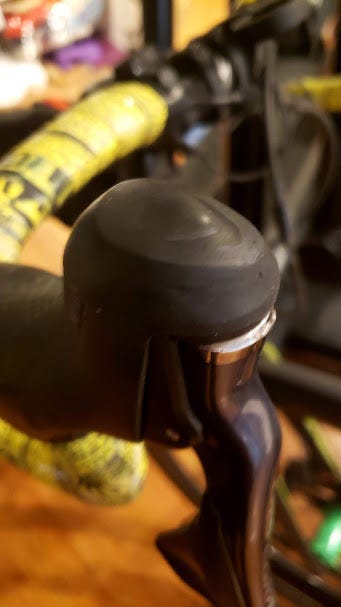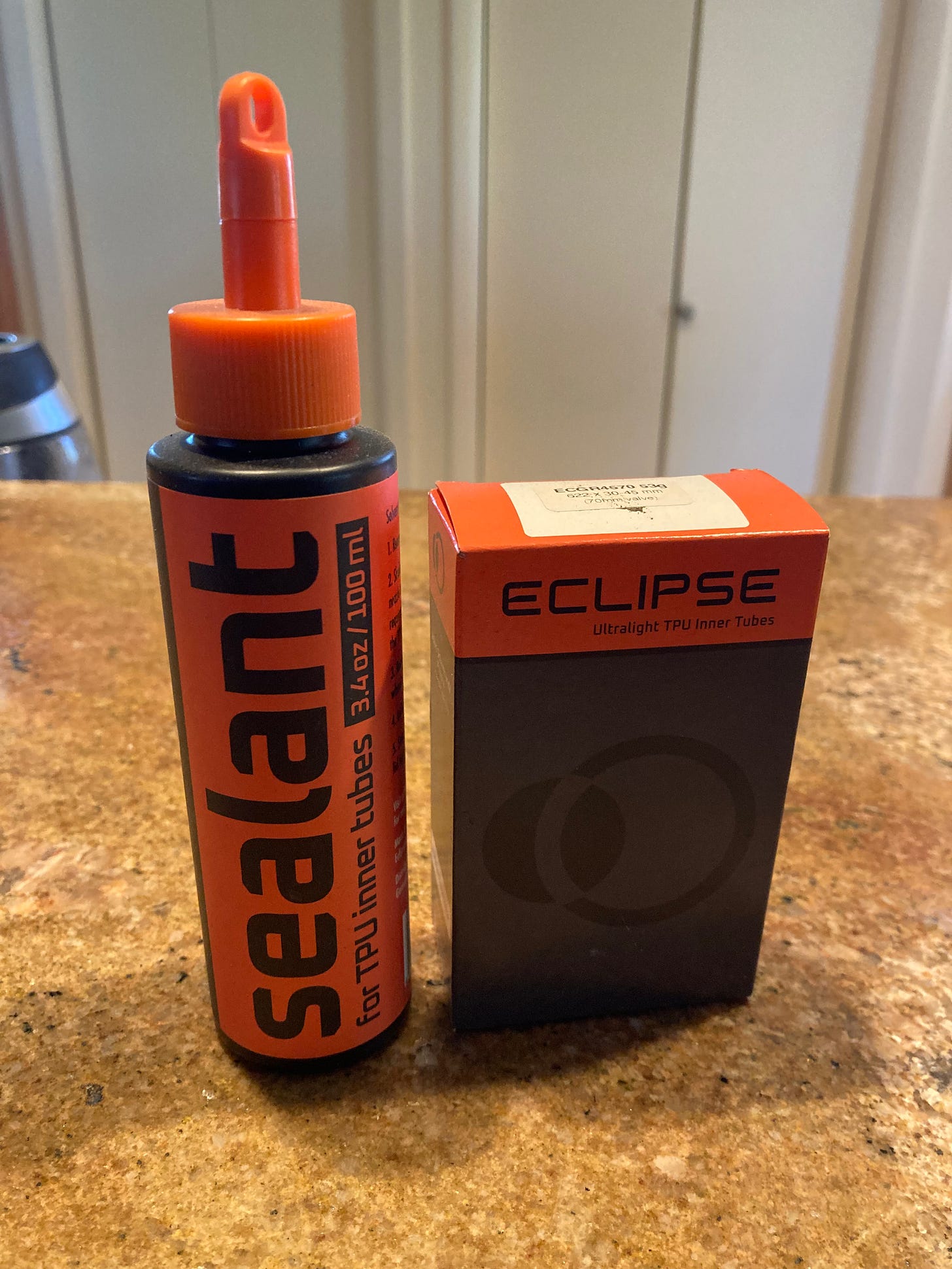Di2 Auxiliary Button Hack, TPU Tubes
Patching and Avoiding Twisting of Thermoplastic Urethane (TPU) Inner Tubes
Dear Readers,
On last week’s discussion of tire sealant, I neglected to include this cool tool to calculate how much sealant to put in any given tire based on its size. My good friend, fellow Substacker, and enthusiastic and learned bike geek James Huang came up with it. Enjoy it, and please let me know how it works for you.
― Lennard
Dear Lennard,
My 2018 11-Spd Di2 Ultegra Shifters have the hood top screen roll buttons, but in the 3 years I've owned this bike, I have always found them awkward and difficult to use. My feeling is that in their attempt to make the buttons hard to hit inadvertently, Shimano instead made them way too difficult to find and press.
In fairness, I use long finger gloves year round, so that gives me a bit less dexterity with the buttons, but even so, the buttons are small and surprisingly stiff. So I decided to try something to fix this, putting some small, but quite firm felt pads on the underside of the hood tops. See photo.
You can't see it in these pics, but when you peel back the hood tops, there is a molded area the buttons fit into, and that's where the pad goes. It does take a bit of care to slide the hoods back over with the pad, but once the pad is in, there is now a pronounced bump up top, which makes the buttons way easier to use, exceeding my expectations.
I did wonder if the pressure from the hoods would be an issue, but the hood rubber is actually very thin and flexible on top, and the button springs are unnecessarily strong, which is one reason I assume they were so hard to use before. Now that I know the hood tops are so flexible, I may try some silicone bumpers, to see if they work even better than the high density felt.
Steve
Dear Steve,
Now that’s a cool Di2 hack! I, too, had often found those buttons atop the Di2 levers more cumbersome to use than not, especially with full-finger gloves, which I also often wear year-around. I didn’t even bother programming them on my last Di2 bike. I’ll bet this would have changed my experience dramatically.
― Lennard
Dear Lennard,
I have moved to TPU [Thermoplastic Urethane] tubes from Rene Herse since a latex tube seam burst in a front tire (I think a ‘rider error’ hitting a pothole may have a caused it) …and the tire flatted quietly, while going down a hill, which had a right turn at the bottom.
That was last May and the resulting crash resulted in a broken right femur. I love how latex rides and I think TPU rides similarly…love the light weight (like latex) and how they hold air (like butyl), and they may be more robust against pinch flats (from what I hear)…but as these are road tires, I don’t run into pinch flats often.
I paid a premium for sure for their ‘metal valve’ TPU offering (with removable valve cores to boot, so they also work in my deep-set rims on my TT bike), but I’m hoping they are more robust than the cheaper polymer valve offerings. Not to jinx me, but they’ve been running since last August with no issues.
Finally, I also hear that Rene Herse has TPU sealant now. They advise the number of ml to match your tire size, so 28ml for a 28mm tire, etc…the small amount is reportedly because it’s ONLY needed to seal holes in the tube, and not to also seal the tire. I think it’s brand new, but interested to hear reviews on it…could that be the ‘cat’s meow’ for road tires?
Tomas
Dear Tomas,
Ouch! Broken femur!
Most latex inner tubes do have a lapped joint, which is what I assume you meant by the seam that failed on yours. They extruded as a single, super-long tube of latex that is cut up into lengths. The ends of each length are brought together to form a circle. The end of one is folded back, and that folded-back section and the last inch or so of the other end are coated with glue. A valve is added, the folded-back edge is flipped down to adhere to the glued section on the other end, and, voilá, you’ve got an inner tube!
Challenge latex tubes do not, however, have those lap-glued ends—its latex tubes are formed into circular toroids from the get-go, one at a time, and are seamless.
Eclipse also has TPU sealant for its TPU tubes. I have had an Eclipse TPU tube properly laden with Eclipse sealant in my rear road tire for a few months now and happily have nothing to report. I do have to add air perhaps every fourth day or so. Otherwise, riding it has been uneventful, which is exactly what you want with an inner tube. Whether that’s “the ‘cat’s meow’ for road tires” remains to be seen…
― Lennard
Dear Lennard,
Re: TPU tubes. I've had good luck with a bit of talc (corn starch these days I guess) in the tire to help reduce the weird slow leaks I've occasionally experienced with them. I just ordered some TPU tube sealant so we'll see how that goes.
Getting the valve to stick out straight given the lack of valve stem nut has been a bit of an OCD inducing struggle on some rims. Otherwise, price aside, they seem to be the best of all worlds if you don't need to run tire inserts. Light weight, low rolling resistance, spares pack small, no sealant mess (well, I guess we'll see but sealant in a tube has got to be > sealant in a tubeless tire), no issues seating tubeless, rim tape leaks, rim-tire interface leaks, sealant oozing through the sidewall, sealant drying out, sealant failing to seal punctures…
Kieselguhr Kid
Dear Kieselguhr Kid,
It’s good you mentioned the replacement of cornstarch for talc to allow your TPU tubes to move more freely inside the tire.
I wonder whether everyone reading this is aware of the dangers of talc. Coating inner tubes with talc baby powder has for probably a century been the traditional way to keep the tube from adhering to the inside of the tire casing. And our bottoms likely were patted with that stuff as babies as we and our mothers inhaled it.
Turns out, that was ill-advised both for inner tubes and babies’ butts, as talc is now regarded as a carcinogen for both inhalation and skin exposure. This is largely due to the high probability of it containing asbestos, since talc deposits tend to abut asbestos deposits in the earth, and mining can mix them.
As for TPU performance and whether they are “the best of both worlds” as you say, I can certainly see TPU tubes replacing tubeless as a safer option for road tires. We have talked a lot here about the potential dangers of road tubeless tires on carbon rims, particularly hookless ones, in road racing.
Keep reading with a 7-day free trial
Subscribe to Technical Q&A with Lennard Zinn to keep reading this post and get 7 days of free access to the full post archives.





